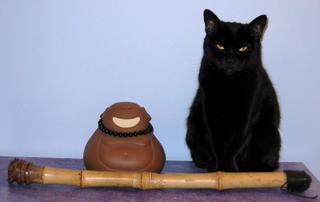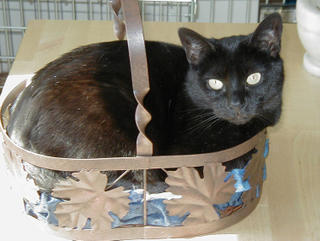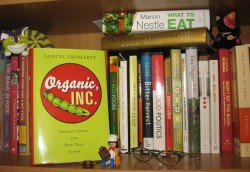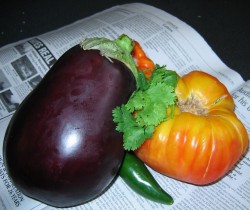The Locavore’s Bookshelf: Organic, Inc.
Samuel Fromartz’ excellent and well-researched book, subtitled, Natural Foods and How They Grew, takes a look at the rise of organic foods from its its infancy as a niche agricultural method practiced by a very few who were often laughed off as cranks and crackpots, to the continually growing, increasingly corporate sector of the food industry. Along the way, he puts the research surrounding organic agricultural techniques, the nutrition content of organic foods, and pesticide residues in the bodies children under the intense focus of his microscopic attention to detail.
It all sounds so very boring, doesn’t it? All of this talk of corporate buy-outs and the ancient history of the organic movement, mixed with a healthy dose of Rachel Carson’s gloom and J.I. Rodale’s visons of health seems guaranteed to put a body to sleep, with or without a glass of warmed organic, rBGH-free milk.
I was surprised to find that this book wasn’t boring at all; in fact, it is written in a style that balances the dogged determination of an investigative journalist ferreting out truth from a tangled skein of myth and misdirection, with the passion of a man on a personal quest. Fromartz starts the book with his own personal background of how he came to want to tell the story of the growth of natural foods from a hippy dream to big business, and from the beginning, he draws the reader in with the power of his electric prose and his ability to convey personality as he tells the individual tales of organic pioneers as a microcosm of the whole movement.
He manages to, in the course of 259 pages, spin the tales of how farmer Jim Cochran came to nearly single-handedly create the methods of growing organic strawberries while making a profit, how soymilk came to be widely available in most supermarkets in the US, and how Kellog’s, current purveyor of empty calorie sugar-frosted cereal horrors, started out as a health-food manufacturer.
He also outlines the recent split in the organic movement between the Organic Consumer Association and the Organic Trade Association over a court case brought by a neo-luddite organic blueberry farmer from Maine, which threatened to completely disassemble the current USDA Certified Organic labelling rules. Fromartz gives a full accounting of the case in true, unbiased journalistic form, filled with the nuances and shades of grey that all court battles which are essentially about semantics, which led me to have a bit more sympathy with Arthur Harvey’s (the blueberry farmer) case, However, I still have to say most of my sympathy lay with the OTA, rather than the OCA. The media fear-mongering media blitz carried out by the OCA that trumpeted the “35 synthetic chemicals allowed in USDA Certified Organic foods” was not based upon solid facts, but rather were the attempts of extremists to get the public to blindly follow their lead, thus setting back the organic food movement by about twenty years.
(For my take on the OCA’s stance on the chemicals, as well as my own listing of the chemicals involved, including annotations on what they are, what they are used for and how the National Organic Standards Board approved of their use, see my 5-part series of articles, written last October: Those Darned Chemicals, TDCII: What is Really Going On Here?, TDCIII: What Are Food Additives, and Why Worry About Them?
,TDCIV: What, Me, Worry?, and finally, TDCV: The Final Confrontation, which contains the complete annotated list of the thirty five synthetic chemicals which the OCA took issue with, along with my final comments. This essay and listing is linked at the OTA website.)
Be that as it may, Fromartz’ book is an outstanding read, and well-worth the time of anyone who is interested in eating locally, organically, or just plain better. Parts of it are funny, parts of it are sad, and parts of it will undoubtedly make many readers angry.
Which is a good thing, as there are many reasons for consumers to become peevish with not only conventional agriculture and factory farming, but also with some large organic producers, such as Horizon Organic, which produces “organic” milk in a factory farm setting.
But, while some of the facts presented in the book will ruffle some feathers, others offer hope for the future of American food, so one need not worry–this is not a tome filled with gloom and doom.
Minna is Home
 I wanted to share the good news: Minnaloushe’s liver enzyme counts are back to normal levels. This fast reversal came about because we caught her anorexic behavior in time to provide aggressive treatement (force-feeding) and whatever it was that started the lack of interest in food is no longer an issue, as she has been eating both soft and dry food in large amounts, twice a day. She is also drinking water well, and there is no sign of permanent kidney or liver damage.
I wanted to share the good news: Minnaloushe’s liver enzyme counts are back to normal levels. This fast reversal came about because we caught her anorexic behavior in time to provide aggressive treatement (force-feeding) and whatever it was that started the lack of interest in food is no longer an issue, as she has been eating both soft and dry food in large amounts, twice a day. She is also drinking water well, and there is no sign of permanent kidney or liver damage.
We brought her home today; we have to isolate her for a while in order to monitor her eating, drinking and output; we will probably keep her isolated from the other cats until she has regained her weight. She seems much more herself–Zak is up in the room where we are keeping her, playing flute for her. (She loves his flute music–the shakuhachi that she is pictured with there–a Japanese end-blown bamboo flute–is one of her favorites. She likes to sit on his lap or wrapped around his shoulders while he plays.)
So that is good news! Look for part IV of “Those Darned Chemicals” later tonight; Part V, which should just be the last of the annotated list of the troublesome food additives will come either tomorrow or the next day.
Thank you all for your support and concern–I am just glad that we don’t have to force feed her for weeks on end.
About Minnaloushe
 I know it isn’t weekend cat blogging time, but I have some not so good news about Zak’s beloved girl cat, Minnaloushe.
I know it isn’t weekend cat blogging time, but I have some not so good news about Zak’s beloved girl cat, Minnaloushe.
She is at the vet hospital right now; she has Feline Hepatic Lipidosis, commonly known as “Fatty Liver Syndrome.”
It happens when a cat stops eating for whatever reason; when they do this, and their bodies resort to metabolizing fat to survive, the liver ends up with fat deposited in its tissues. For whatever reason, cats are not efficient at metabolizing body fat, so it tends to build up in the liver and cause liver failure.
We have lost a cat in the past to this, over a decade ago, before vets knew much about it and how to treat it.
It is, however, treatable, and since we caught it so early, Minna has a good chance to pull through. What we have to do is force-feed her and give her IV fluids until her body stops metabolizing itself to survive. At that point, the liver damage is reversable. It just means that we may end up feeding her either through a stomach tube, or forcing food from a syringe into her mouth, for six or eight weeks.
I just thought I should let my readers know. For one thing, lots of you are cat lovers and know how Zak and Morganna and I dote on our kitties, and you would understand. For another thing, I don’t know how much time I will be able to devote to the blog if we are going to be running a kitty convalescence center in addition to getting our kitchen redone and keeping all and sundry fed and happy.
I will still finish “Those Darned Chemicals,” though, and I have lots of other stuff planned, including a new installment of “The Chinese Cookbook Project.” So, stay tuned and wish us all luck.
Thanks.
Public Enemy Number One: The Kitten
 The only reason the little git yet lives is because he is so damned cute.
The only reason the little git yet lives is because he is so damned cute.
I was nearly finished with Part Four of the seemingly never-ending series of “Those Darned Chemicals” when Mr. Pain in my Tuchus decided to step on the switch to the power bar/surge protector on my computer.
And I lost the whole blessed post.
The little twit.
And he just skittered under my desk again. (Only to be chased out with a well-placed hiss from me and muttered threats of beheading.)
I wonder how he would taste, sauteed with butter and garlic?
Or perhaps I should stir fry him with garlic, and scallions with just a hint of sesame oil at the end?
I am going to leave off with the writing now and recreate the post on Monday. I have too many other things to do today to worry about it.
I can’t believe it! He went back there AGAIN! ARGH!!!!!
Food In The News: Is Organic Cane Sugar a Health Food And Other Burning Questions
Since When Is Cane Sugar A Health Food? Zak sent me a link to an extremely interesting NY Times article where I learned that since consumers have decided that high fructose corn syrup is the devil that has caused rampant obesity in the United States (and yes, it may be -one- factor among -many- involved in the obesity problem–but by no means should anyone believe it is the sole cause), cane sugar is being used as an ingredient in many processed foods, and this fact is being used as a marketing tool.
Which is fine–there are people who want to avoid HFCS, and that is great, so labeling the absence of it and the presence of cane sugar is fine. However, calling cane sugar a “healthy alternative” to HFCS is stretching the truth just a wee bit.
Oh, hell, let’s just say it is patent bull crap. Sugar is still not good for you in large quantities, no matter whether it comes from sugar cane, beets or corn. Cane sugar may be more cleanly metabolized by our bodies, but it is still sugar, and frankly, I don’t think it needs to be in every brand of spaghetti sauce, salad dressing and bread in copious amounts on the grocery store shelf.
Mark Bittman Says: Eat Better Food, Don’t Worry About Organic I like Mark Bittman. Even when I disagree with him, I like him–he just has such a sensible, no-nonsense way of putting his opinions that I respect and enjoy. In his recent article in the NY Times, Eating Food That’s Better For You, Organic Or Not, he points out that he would rather see Americans eating more conventionally or organically grown fruits and vegetables and other whole, minimally processed foods than have them get the idea that an organic Oreo cookie is somehow healthier than a regular Oreo cookie.
And that is a point that I have found over and over in talking with people who are not in my immediate circle of friends. A lot of people in this country have the idea that the USDA Organic label on a package of cookies, crackers or cereal instantly imbues that particular food with immediate healthy to eat status, which is just not true. “Organic” does not necessarily equate with “healthy,” “sustainable,” or “local,” when it comes to food. All it means is that the food is grown without chemical fertilizers and pesticides, that it has not been treated with sewage sludge and that it has been processed with minimal artificial ingredients and chemicals. That’s it.
As Bittman points out, it can be organically grown in China, then shipped to the United States, which is still not very sustainable. And as he quotes author and nutritionist Marion Nestle, “Organic junk food is still junk food.”
So, as he says, let’s all get off our duffs and eat more vegetables and fruits and leave the organic Oreos to themselves.
Will The Food Revolution Be Televised? If you get the reference to the subhead for this bit, you get a cookie, because you win extra points for obscure cultural awareness. Zak, you don’t count, because I know you know what I am talking about.
Once again, we come to a NY Times article, Is a Food Revolution Now In Season? to see that all of those foodie activists and authors I have been reading and writing about for years: Alice Waters, Michael Pollan, Eric Schlosser and Marion Nestle, thrilled to finally have their voices heard by the new presidential administration. So thrilled in fact, that they are pushing their agenda for a better, healthier food system for the United States, that they are heading to Washington, writing letters, meeting with Tom Vilsack, our new Secretary of Agriculture, and First Lady Michelle Obama, armed with copies of the film, Food, Inc.
Of course, the change these activists want will not come as fast as they want, but it appears that even among farm-state Senators, copies of Michael Pollan’s The Omnivore’s Dilemma are being seen tucked in briefcases and under arms.
That leads me to think that change is coming–faster than I expected, but still slowly.
And that is fine–as any ecologist or gardener will tell you, slow, steady change is the way natural systems work.
Fast change is what is likely to be unsustainable and not stick. Slow change is the way to work toward long-term goals.
Powered by WordPress. Graphics by Zak Kramer.
Design update by Daniel Trout.
Entries and comments feeds.




